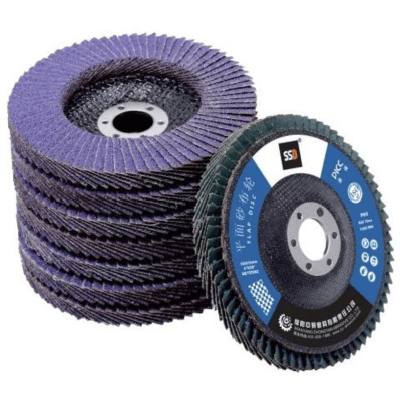Flap Wheels Unleashed: A Deep Dive into Their Applications and Advantages
Flap wheels are unsung heroes in workshops and industries worldwide, blending the cutting power of abrasives with the flexibility to tackle curved, uneven, or hard-to-reach surfaces. These tools—made of overlapping sandpaper flaps mounted on a rotating core—have become indispensable for tasks ranging from rust removal to precision polishing. Their unique design makes them more versatile than rigid sandpaper or grinding discs, adapting to shapes and materials that other tools struggle with. Let’s explore the wide-ranging applications of flap wheels and the key advantages that make them a top choice in countless fields.
Applications of Flap Wheels: Where They Shine
Flap wheels excel in diverse industries, thanks to their ability to handle everything from heavy grinding to fine finishing. Here’s how they’re used across different fields:
1. Automotive Repair and Restoration
Cars, trucks, and motorcycles have curved body panels, tight wheel wells, and intricate parts—perfect for flap wheels:
- Rust removal: Coarse-grit (36–80) flap wheels strip rust from fenders, door frames, and undercarriages without damaging the underlying metal. Their flexibility reaches into crevices where rigid tools can’t.
- Paint prep: Medium-grit (120–180) flap wheels scuff old paint or primer, creating a rough surface for new paint to adhere to. Fine-grit (240–400) wheels smooth primer, ensuring a flawless finish.
- Weld smoothing: After repairing a bumper or frame, flap wheels blend weld seams into the surrounding metal, making them invisible to the eye.
For example, restoring a classic car often involves using flap wheels to remove decades of rust from curved fenders—something sandpaper would take hours to do unevenly.
2. Metalworking and Fabrication
In metal shops, flap wheels handle everything from raw steel to delicate alloys:
- Deburring: After cutting metal sheets or pipes, sharp edges (burrs) can cause injury. Flap wheels gently round these edges, leaving safe, smooth surfaces.
- Smoothing welds: Welds on steel structures (like fences or machinery) are rough. Flap wheels grind them down to match the rest of the metal, improving both safety and appearance.
- Polishing stainless steel: Fine-grit flap wheels (400–600) give stainless steel appliances, handrails, or tools a mirror-like finish, removing scratches and dullness.
Fabricators prefer flap wheels for their ability to work on both flat and curved metal—like smoothing the inside of a bent pipe or polishing a rounded bracket.
3. Woodworking and Furniture Making
Woodworkers rely on flap wheels to shape and finish projects without damaging the material:
- Sanding curves: Chairs, table legs, and wooden bowls have rounded edges that rigid sandpaper can’t reach. Spiral-wound flap wheels conform to these shapes, ensuring even sanding.
- Removing paint or varnish: Coarse-grit flap wheels strip old finishes from wooden furniture, saving time compared to hand sanding.
- Finishing touches: Fine-grit flap wheels smooth wood after sanding, preparing it for staining or painting. They leave a softer, more uniform surface than sandpaper.
A furniture restorer, for example, might use a 3-inch flap wheel to sand the curved arms of a vintage chair, achieving a smooth finish in minutes instead of hours.

4. Aerospace and Precision Manufacturing
In high-stakes industries like aerospace, where precision matters, flap wheels are used to refine critical parts:
- Smoothing aircraft components: Turbine blades, engine parts, and aluminum panels require flawless finishes to reduce drag and ensure safety. Fine-grit flap wheels (400–600) remove micro-scratches from these parts.
- Deburring after machining: CNC-machined parts often have tiny burrs that can cause malfunctions. Flap wheels gently remove these without altering the part’s dimensions.
- Working with composites: Modern planes use composite materials (like carbon fiber). Flap wheels with silicon carbide abrasives smooth these delicate materials without causing fraying or damage.
Aerospace technicians trust flap wheels for their precision—they remove material gradually, avoiding the over-grinding that could ruin expensive parts.
5. DIY and Home Repairs
For homeowners and hobbyists, flap wheels simplify everyday projects:
- Fixing metal tools: A rusty garden rake or a dented mailbox can be restored with a medium-grit flap wheel, removing rust and smoothing dents.
- Prepping metal for painting: A metal gate or fence can be scuffed with a flap wheel before painting, ensuring the paint adheres well.
- Sharpening and cleaning: Flap wheels with fine grit can touch up dull scissors or clean corrosion from battery terminals, making them useful for small repairs.
Even casual DIYers find flap wheels easier to use than sandpaper—they attach to a simple die grinder, reducing hand fatigue during long projects.
Key Advantages of Flap Wheels
What makes flap wheels stand out from other abrasive tools? Their unique design and features offer clear benefits:
1. Flexibility for Curved and Complex Surfaces
Unlike rigid grinding discs or sandpaper sheets, flap wheels bend and conform to shapes. The overlapping flaps move independently, allowing the tool to follow curves, angles, and crevices. This makes them ideal for surfaces that are anything but flat—like car fenders, pipe bends, or wooden chair legs.
2. Controlled Material Removal
Flap wheels remove material gradually, reducing the risk of over-grinding. The flaps wear down evenly, ensuring consistent performance. This is critical for delicate tasks, like smoothing a thin metal sheet or refining a wooden detail—you’re less likely to accidentally cut through the material.
3. Longer Lifespan Than Sandpaper
A single flap wheel lasts much longer than a sheet of sandpaper. As the outer flaps wear down, new abrasive material is exposed, extending the tool’s life. For example, a 4-inch aluminum oxide flap wheel can sand for 1–2 hours straight, while a sheet of sandpaper might need replacing every 10–15 minutes.
4. Reduced Vibration and User Fatigue
Flap wheels are balanced and designed to spin smoothly, creating less vibration than rigid discs. This makes them easier to hold for long periods, reducing hand and arm fatigue—a big plus for professionals who use them all day.
5. Versatility Across Materials
With the right abrasive, flap wheels work on metal, wood, plastic, composites, and more. Aluminum oxide handles steel and wood; zirconia alumina tackles tough metals like stainless steel; silicon carbide is gentle on aluminum and plastic. This versatility means one tool can handle multiple tasks, saving space and money.
6. Less Dust and Clogging
The overlapping flaps allow dust to escape, reducing clogging. This is especially helpful when working with soft materials like aluminum or wood, which tend to gum up sandpaper. A clean flap wheel stays sharp longer, ensuring efficient grinding.
FAQ
What’s the difference between aluminum oxide and zirconia alumina flap wheels?
Aluminum oxide is affordable and works for general tasks (steel, wood). Zirconia alumina is harder, lasts longer, and is better for tough materials like stainless steel or heavy grinding.
Can flap wheels be used on plastic?
Yes, but use silicon carbide abrasive (fine grit, 240+) to avoid scratching. Apply light pressure to prevent melting the plastic.
How do I choose the right grit size for my project?
Start with coarse grit (36–80) for removing rust, paint, or welds. Use medium grit (120–180) to smooth scratches. Finish with fine grit (240–600) for polishing or paint prep.
Are flap wheels better than sandpaper for woodworking?
For curved or detailed wood, yes. They conform to shapes and save time. For flat surfaces, sandpaper may be faster, but flap wheels leave a smoother finish.
Can I use a flap wheel on an angle grinder?
Yes, most flap wheels fit standard angle grinders. Check the wheel’s diameter to match your grinder (common sizes: 4–7 inches).
How do I clean a clogged flap wheel?
Tap it gently to shake off dust, or use a wire brush to remove built-up material. Avoid water, as it can loosen the glue holding the flaps.
Are flap wheels safe for beginners?
Yes, with proper safety gear (glasses, mask, gloves). Start with light pressure and practice on scrap material to get comfortable.
Table of Contents
- Flap Wheels Unleashed: A Deep Dive into Their Applications and Advantages
- Applications of Flap Wheels: Where They Shine
-
Key Advantages of Flap Wheels
- 1. Flexibility for Curved and Complex Surfaces
- 2. Controlled Material Removal
- 3. Longer Lifespan Than Sandpaper
- 4. Reduced Vibration and User Fatigue
- 5. Versatility Across Materials
- 6. Less Dust and Clogging
- FAQ
- What’s the difference between aluminum oxide and zirconia alumina flap wheels?
- Can flap wheels be used on plastic?
- How do I choose the right grit size for my project?
- Are flap wheels better than sandpaper for woodworking?
- Can I use a flap wheel on an angle grinder?
- How do I clean a clogged flap wheel?
- Are flap wheels safe for beginners?


